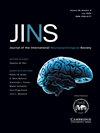80 Longitudinal Development of Response Inhibition in Adolescence and Young Adulthood and Associations with Gray Matter Architecture
IF 2.6
4区 心理学
Q2 CLINICAL NEUROLOGY
Journal of the International Neuropsychological Society
Pub Date : 2023-12-22
DOI:10.1017/s1355617723003983
引用次数: 0
Abstract
Objective:The present study explored how individual differences and development of gray matter architecture in inferior frontal gyri (IFG), anterior cingulate (ACC), and inferior parietal lobe (IPL) relate to development of response inhibition as measured by both the Stop Signal Task (SST) and the Go/No-Go (GNG) task in a longitudinal sample of healthy adolescents and young adults. Reliability of behavioral and neural measures was also explored.Participants and Methods:A total of 145 individuals contributed data from the second through fifth timepoints of an accelerated longitudinal study focused on adolescent brain and behavioral development at the University of Minnesota. At baseline, participants were 9 to 23 years of age and were typically-developing. Assessment waves were spaced approximately 2 years apart. Behavioral measures of response inhibition collected at each assessment included GNG Commission Errors (CE) and the SST Stop Signal Reaction Time (SSRT). Structural T1 MRI scans were collected on a Siemens 3 T Tim Trio and processed with the longitudinal Freesurfer 6.0 pipeline to yield cortical thickness (CT) and surface area values. Regions of interest based on the Desikan-Killiany-Tourville atlas included IFG regions (pars opercularis (PO) and pars triangularis (PT)), ACC and IPL. The cuneus and global brain measures were evaluated as control regions. Retest stability of all measures was calculated using the psych package in R. Mixed linear effects modeling using the lme4 R package identified whether age-based trajectories for SSRTs and GNG CEs best fit linear, quadratic, or inverse curve. Then, disaggregated between- and within-subjects effects of regional cortical architecture measures were added to longitudinal behavioral models to identify individual differences and developmental effects, respectively.Results:Both response inhibition metrics demonstrated fair reliability and were best fit by an inverse age trajectory. Neural measures demonstrated excellent retest stability (all ICCs > 0.834). Age-based analyses of regional CT identified heterogeneous patterns of development, including linear trajectories for ACC and inverse age trajectories for bilateral PT. Individuals with thinner left PO showed worse performance on both response inhibition tasks. SSRTs were related to individual differences in right PO thickness and surface area. A developmental pattern was observed for right PT cortical thickness, where thinning over time was related to better GNG performance. Lower surface area of the right PT was related to worse GNG performance. No individual differences or developmental patterns were observed for the ACC, IPL, cuneus, or global metrics.Conclusions:This study examined the adolescent development of response inhibition and its association with cortical architecture in the IFG, ACC and IPL. Separate response inhibition tasks demonstrated similar developmental patterns with steepest improvements in early adolescence and relationships with left PO thickness, but each measure had unique relationships with other IFG regions. This study indicates that a region of the IFG, the par opercularis, relates to both individual difference and developmental change in response inhibition. These patterns suggest brain-behavior association that could be further explored in functional imaging studies and that may index, in vulnerable individuals, risk for psychopathology.80 青春期和青年期反应抑制的纵向发展及其与灰质结构的关系
目的:本研究以健康青少年和年轻成年人为纵向样本,通过停止信号任务(SST)和去/不去(GNG)任务测量反应抑制的发展,探讨了个体差异以及下额回(IFG)、前扣带回(ACC)和下顶叶(IPL)灰质结构的发展与反应抑制发展之间的关系。研究还探讨了行为和神经测量的可靠性。参与者和方法:在明尼苏达大学进行的一项以青少年大脑和行为发展为重点的加速纵向研究中,共有 145 人提供了第二至第五个时间点的数据。基线时,参与者的年龄在 9 到 23 岁之间,属于典型发育阶段。评估波间隔约为 2 年。每次评估收集的反应抑制行为测量包括 GNG 委员会错误 (CE) 和 SST 停止信号反应时间 (SSRT)。结构 T1 MRI 扫描由西门子 3 T Tim Trio 采集,并使用纵向 Freesurfer 6.0 管道进行处理,以获得皮质厚度 (CT) 和表面积值。基于 Desikan-Killiany-Tourville 地图集的研究区域包括 IFG 区域(厣旁 (PO) 和三角旁 (PT))、ACC 和 IPL。楔叶和全脑测量作为对照区域进行评估。使用 lme4 R 软件包进行混合线性效应建模,以确定基于年龄的 SSRT 和 GNG CEs 的轨迹是否最符合线性、二次或反向曲线。然后,在纵向行为模型中加入了区域皮层结构测量的受试者间效应和受试者内效应,以分别确定个体差异和发展效应。神经测量指标显示出极好的重测稳定性(所有 ICCs 均为 0.834)。基于年龄的区域 CT 分析确定了不同的发展模式,包括 ACC 的线性轨迹和双侧 PT 的逆年龄轨迹。左侧PO较薄的个体在两项反应抑制任务中的表现都较差。SSRT与右侧PO厚度和表面积的个体差异有关。右侧PT皮层厚度呈发展模式,随着时间的推移变薄与更好的GNG表现有关。右侧 PT 表面积较小与 GNG 成绩较差有关。结论:本研究考察了青少年反应抑制能力的发展及其与IFG、ACC和IPL皮层结构的关联。不同的反应抑制任务表现出相似的发展模式,在青春期早期改善最快,并与左侧PO厚度有关,但每种测量方法都与其他IFG区域有独特的关系。这项研究表明,IFG 的一个区域--腕旁--与反应抑制的个体差异和发展变化都有关系。这些模式表明,大脑与行为之间存在关联,可在功能成像研究中进一步探讨,并可在易受影响的个体中显示精神病理学的风险。
本文章由计算机程序翻译,如有差异,请以英文原文为准。
求助全文
约1分钟内获得全文
求助全文
来源期刊
CiteScore
5.40
自引率
3.80%
发文量
185
审稿时长
4-8 weeks
期刊介绍:
The Journal of the International Neuropsychological Society is the official journal of the International Neuropsychological Society, an organization of over 4,500 international members from a variety of disciplines. The Journal of the International Neuropsychological Society welcomes original, creative, high quality research papers covering all areas of neuropsychology. The focus of articles may be primarily experimental, applied, or clinical. Contributions will broadly reflect the interest of all areas of neuropsychology, including but not limited to: development of cognitive processes, brain-behavior relationships, adult and pediatric neuropsychology, neurobehavioral syndromes (such as aphasia or apraxia), and the interfaces of neuropsychology with related areas such as behavioral neurology, neuropsychiatry, genetics, and cognitive neuroscience. Papers that utilize behavioral, neuroimaging, and electrophysiological measures are appropriate.
To assure maximum flexibility and to promote diverse mechanisms of scholarly communication, the following formats are available in addition to a Regular Research Article: Brief Communication is a shorter research article; Rapid Communication is intended for "fast breaking" new work that does not yet justify a full length article and is placed on a fast review track; Case Report is a theoretically important and unique case study; Critical Review and Short Review are thoughtful considerations of topics of importance to neuropsychology and include meta-analyses; Dialogue provides a forum for publishing two distinct positions on controversial issues in a point-counterpoint format; Special Issue and Special Section consist of several articles linked thematically; Letter to the Editor responds to recent articles published in the Journal of the International Neuropsychological Society; and Book Review, which is considered but is no longer solicited.

 求助内容:
求助内容: 应助结果提醒方式:
应助结果提醒方式:


